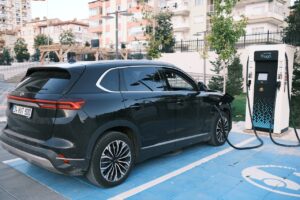
Home / EV Charging News / Electric Cars and the Future of Autonomous Shuttles
The intersection of electric cars and autonomous technology is heralding a new era in urban transportation. This dynamic partnership holds the promise of revolutionizing the way we navigate cities, particularly through the emergence of autonomous electric shuttles. This article takes a closer look at the transformative impact of these futuristic vehicles, uncovering how they are reshaping public transportation and addressing the crucial challenge of last-mile connectivity in urban areas.
As cities grow and evolve, so too must our approach to mobility. Traditional public transportation systems face challenges, especially in providing efficient last-mile connectivity. Enter autonomous electric shuttles, positioned at the forefront of innovation, poised to redefine urban mobility by seamlessly connecting commuters from their doorstep to their destination.
Autonomous electric shuttles are not just vehicles; they represent a seamless integration into the fabric of urban life. With their emission-free electric propulsion, they contribute to sustainability goals, while their autonomous capabilities promise safer and more efficient journeys. The urban landscape is becoming a canvas where these shuttles paint a picture of connected, green, and intelligent transportation.
The perennial challenge of last-mile connectivity has been a puzzle for urban planners. Autonomous electric shuttles emerge as a missing piece, adept at navigating the intricate web of urban streets and efficiently closing the gap between major transit hubs and the final destination. This newfound connectivity reduces reliance on personal vehicles, easing traffic congestion and contributing to a more streamlined urban transportation ecosystem.
Public transportation is undergoing a facelift with the integration of autonomous electric shuttles. Commuters experience a more personalized and convenient journey as these shuttles operate on flexible routes, adapting to real-time demand. The promise of reduced waiting times and optimized routes transforms the public transportation experience, making it more attractive and accessible to a broader demographic.
Safety and efficiency are paramount in the narrative of autonomous electric shuttles. Leveraging advanced sensors, cameras, and machine learning algorithms, these vehicles navigate urban environments with precision. The result is a transportation mode that not only enhances safety standards but also optimizes traffic flow, contributing to overall urban mobility efficiency.
The integration of autonomous electric shuttles faces both technological and social challenges. Technologically, refining the algorithms for complex urban scenarios and ensuring fail-safes remain ongoing tasks. Socially, acceptance and trust in autonomous technology require proactive engagement and education. Addressing these frontiers is essential for the widespread adoption and success of this transformative mode of urban transportation.
Beyond the immediate conveniences, the economic and environmental impacts of autonomous electric shuttles are substantial. By reducing individual car ownership, these shuttles contribute to lowered traffic congestion, decreased emissions, and a more sustainable urban environment. Additionally, the shift toward a shared mobility model can influence economic patterns, creating new opportunities and reshaping traditional transportation economies.
While the vision of autonomous electric shuttles holds immense promise, navigating the road ahead involves addressing challenges and fostering collaborations. Technical hurdles such as perfecting navigation in complex urban scenarios and enhancing cybersecurity measures require ongoing innovation. Collaborations between governments, tech companies, and urban planners are pivotal to create a regulatory framework that ensures safety, reliability, and integration into existing transportation systems.
The successful integration of autonomous electric shuttles into urban transportation necessitates active community engagement. As these shuttles become a regular feature of city life, understanding and addressing public concerns, perceptions, and expectations are crucial. Open dialogues, pilot programs, and educational initiatives help build trust and create a sense of ownership among the communities these shuttles serve.
The rise of autonomous electric shuttles aligns with the broader concept of smart cities. Integrating these shuttles into a city’s overall smart infrastructure facilitates seamless coordination with traffic signals, other autonomous vehicles, and transportation hubs. This interconnected ecosystem lays the foundation for a comprehensive and intelligent urban mobility network.
The advent of autonomous electric shuttles prompts a reevaluation of traditional transportation business models. Ride-sharing services, public-private partnerships, and mobility-as-a-service platforms become integral components. These evolving business models not only address economic aspects but also redefine the accessibility and affordability of urban transportation.
The success of autonomous electric shuttles hinges on their accessibility and inclusivity. Ensuring that these services cater to diverse demographics, including individuals with mobility challenges or those in underserved communities, is essential. Designing vehicles and infrastructure that prioritize inclusivity contributes to the democratization of efficient and equitable urban mobility.
As autonomous electric shuttles gain traction, understanding and accommodating cultural nuances and regulatory variations across different regions become imperative. Customizing solutions to fit the unique characteristics of each urban landscape ensures successful global adoption. Recognizing the diversity in city layouts, traffic patterns, and user behaviors allows for a nuanced approach to implementation.
The integration of autonomous electric shuttles prompts a rethinking of urban planning. Traditional road-centric models shift towards centralized mobility hubs where shuttles, public transit, and other transportation modes converge. This hub-and-spoke model optimizes efficiency and enhances the overall accessibility of urban transportation.
In conclusion, the confluence of electric cars and autonomous shuttles represents a renaissance in urban mobility. As these vehicles traverse the streets, they bring forth not just a mode of transportation but a catalyst for urban transformation. Overcoming challenges, fostering collaborations, and reimagining urban landscapes are integral to realizing the full potential of autonomous electric shuttles. In this dynamic journey, cities are not just adopting a new mode of transport; they are shaping the future pulse of urban life.
$2,890.00 Original price was: $2,890.00.$2,690.00Current price is: $2,690.00.
$4,150.00 Original price was: $4,150.00.$3,790.00Current price is: $3,790.00.
$1,650.00 Original price was: $1,650.00.$1,490.00Current price is: $1,490.00.
$2,290.00 Original price was: $2,290.00.$2,150.00Current price is: $2,150.00.
$1,290.00 Original price was: $1,290.00.$799.00Current price is: $799.00.
$10,690.00 – $11,390.00




Your Power Management Partner for Over 25 Years Future Generations Depend on Our Decisions Today ™
2024 © All rights reserved by CyberSwitching